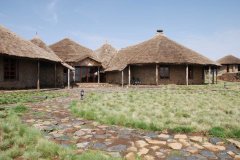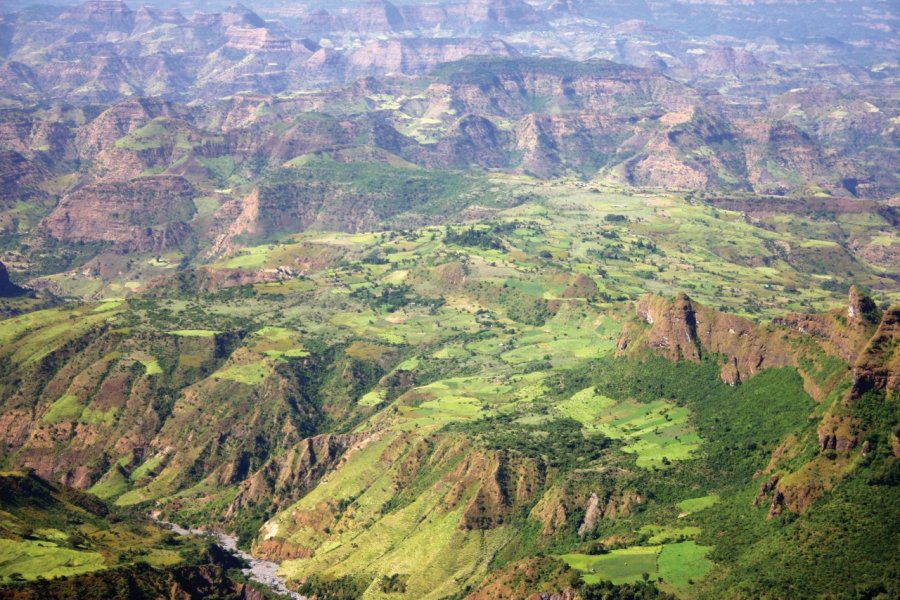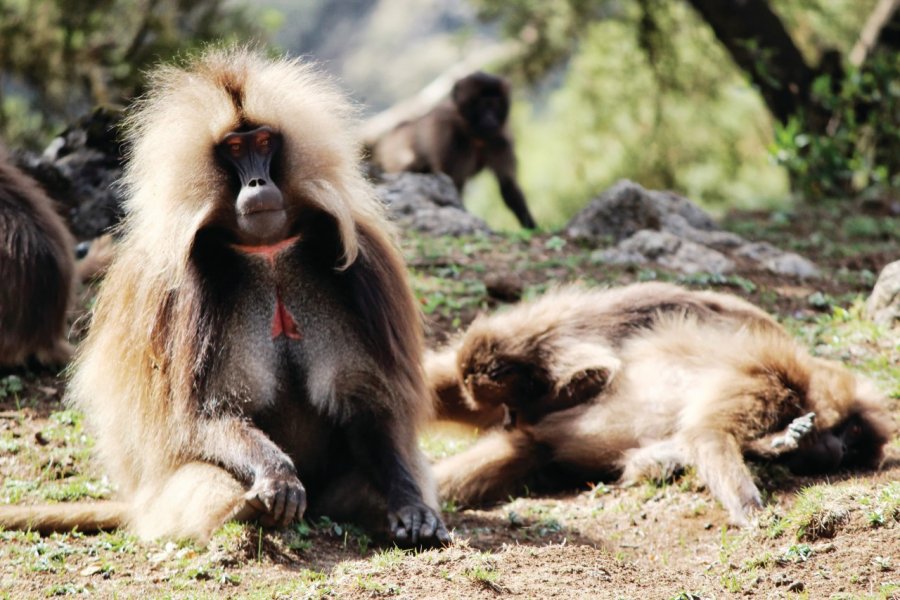Travel Guide Parc National Du Simien
Find an accommodation
Advertising
"The grandest of all Abyssinian landscapes appeared to us as we gazed up at the amethyst-purple clouds of the Simien peaks. A thousand years ago, when the ancient gods ruled Ethiopia, they must have played chess with these gigantic craggy rocks... We could make outbishop 's bolsters carved from lapis lazuli, ruby-red towers in the setting sun approaching their battlements, an emerald knight where the forest climbed the rock and, far away, a sapphire-crowned king guarded by a row of pawns.. When the gods exchanged their game for shields to fight men who vociferated claims against them, they turned the pieces of their chessboard into mountains. In Simien, they stand enchanted, until the world becomes pagan again, and titans and gods once more lean from the edge of the clouds to bet a star or two on their games."(From Red Sea to Blue Nile, a Thousand Miles of Ethiopia, Rosita Forbes, 1925.)A national park featuring Africa's third highest peak. The result of intense volcanic activity some 40 million years ago, the Simien is a chaos that has been shaped by erosion over the centuries into an improbably steep relief of peaks, narrow valleys and tabular plateaus(amba). The center of the park, from south to north, consists of a large, undulating plateau that ends in a very impressive escarpment some 1,500 m deep to the west and north. The edge of this cliff is jagged and criss-crossed by beautiful gorges. The landscape opens up towards Mulit and Mekarebia, with rocky peaks - the remains of ancient volcanoes - and deeply incised valleys some 1,000-2,000 m below. The "peaks" at 4,000 m and above are not true peaks, but gently sloping plateaus that end in cliffs. Ras Dashen is Ethiopia's highest point at 4,550 m and Africa's third highest peak behind Kilimanjaro and Mount Kenya. But this valley is less beautiful than that of Mount Bawiit, where you can see escarpments and volcanic peaks. While the ascent to the "roof of Ethiopia" is highly symbolic, it's not the most beautiful trek in terms of scenery (because of the road that cuts through the mountain to the summit and pebbled landscapes) and cultural immersion (we stay in trekker camps). The Bale Mountains (for the preservation of nature) and the Lasta Mountains (for the churches, village accommodation and diversity of landscapes) are more varied in terms of discoveries. You really need to choose your itinerary carefully if you want to make a good trek and cut out the uninteresting parts of the ascent from Debark. On the other hand, there are plenty of animals to be seen in the higher elevations, particularly gelada baboons.Difficult preservation of the park. Created in 1969 over an area of 179 km2to protect the endemic species that inhabit it, the Simien Park (which means "north" in Amharic), a Unesco World Heritage Site, is a fantastic excursion destination for trekking enthusiasts. Aware of the ecological wealth of the site and its tourist attractions, the regional and federal authorities, supported by Austrian cooperation, are trying to strike the right balance between the development of new infrastructures and the preservation of the biotope, which involves raising awareness of conservation needs among the resident communities. The park's dense population, made up of orthodox Amhara and a small Muslim minority, clings to these thankless lands and survives on livestock and meagre agriculture, at the risk of further reducing the habitat area for fragile animal and plant species.In 2017, the World Heritage Committee met to highlight Ethiopia's efforts to safeguard the Simien and removed the site from the list of heritage in danger. Threats to the park included "human settlement, cultivation and soil erosion, particularly around the village of Gich; frequent fires in the heather forests; excessive livestock and livestock numbers. Agricultural and pastoral activities, including the cultivation of large areas of the property and the grazing of large numbers of livestock, have severely affected the natural values of the property, particularly the fragile habitat of the Walia ibex and the Ethiopian wolf". This was a complex problem to solve, especially as 80% of the park was inhabited by humans. Villages, cultivated fields, cows and goats, and peasants, adults and children alike, could be seen constantly on the horizon as they hiked up the mountain to accompany their animals to pasture, or to reach the famous road that led them to Debark.Although the villagers have been relocated in return for compensation - once the road has been cut, it's difficult to stay in these isolated areas - Unesco wants to extend the protected area of the Simien Park to include the Masarerya and Limalimo reserves, as well as the Ras Dejen and Silki-Kidis Yared sectors, and the corridors linking them, which are neither inhabited nor cultivated and are populated by the main species of the Simien. Ethiopia, which values its tourists, was praised for "building an alternative road to reduce the nuisance of the main road that crosses the property, reduce overgrazing and the impact of tourism", as well as for preserving the areas of the Abyssinian ibex and the gelada primate.
What to visit Parc National Du Simien?
Advertising
Suggested addresses Parc National Du Simien
Weather at the moment
Advertising
Organize your trip with our partners Parc National Du Simien
Transportation
Book your plane tickets
Car Rental
Boat rental
Accommodation & stays
Find a hotel
Holiday rental
Find your campsite
Tailor-made trip
Immersion travel
Services / On site
Activities & visits
Find a doctor
Parc National Du Simien travel inspiration
Find unique Stay Offers with our Partners
Pictures and images Parc National Du Simien
Other destinations nearby Parc National Du Simien
25 km away
100 km away







